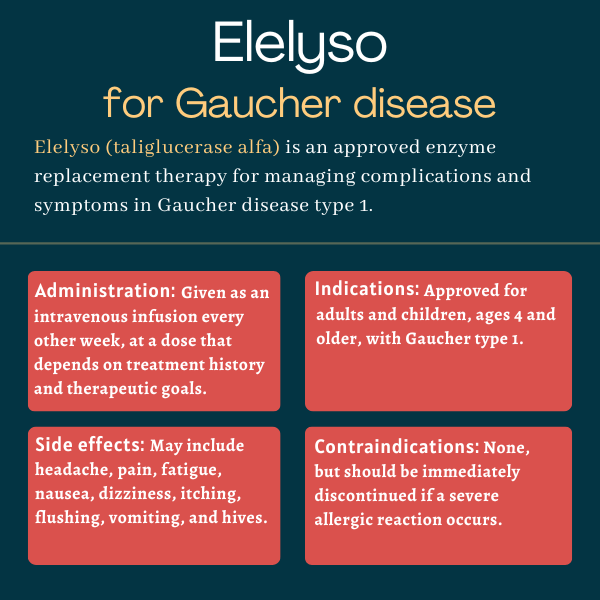Elelyso (taliglucerase alfa) for Gaucher disease
Last updated April 24, 2025, by Inês Martins, PhD

What is Elelyso for Gaucher disease?
Elelyso (taliglucerase alfa) is an approved enzyme replacement therapy (ERT) used to manage certain complications and alleviate symptoms of Gaucher disease type 1 in adults and children aged 4 and older.
Administered via into-the-vein, or intravenous, infusions, the therapy works by delivering taliglucerase alfa, a lab-made version of the glucocerebrosidase (GCase) enzyme that’s missing in Gaucher disease.
GCase deficiency leads to the toxic accumulation of a fatty molecule called glucocerebroside in cells, particularly in immune cells called macrophages, damaging various tissues and organs.
Gaucher type 1, the most common form of the disease, results in a range of signs and symptoms, with the most common being an enlarged spleen and liver, as well as low levels of red blood cells and of blood-clotting fragments called platelets.
Taliglucerase alfa differs slightly from the natural GCase enzyme, a modification that enables its movement into key cellular compartments. Another key feature is that it’s produced in genetically engineered carrot cells, which add specific sugar molecules to the enzyme to ensure its uptake by macrophages.
This guarantees the enzyme is picked up by the right cells after being administered into the bloodstream, helping to reduce glucocerebroside buildup and slowing Gaucher progression.
The therapy was developed by Protalix Therapeutics in collaboration with Pfizer, which markets it in most countries.
Therapy snapshot
| Brand name: | Elelyso |
| Chemical name: | Taliglucerase alfa |
| Usage: | Used to manage complications and ease symptoms of Gaucher type 1 |
| Administration: | Intravenous infusion |
Who can take Elelyso?
Elelyso is approved in the U.S. for treating Gaucher disease type 1 in adults and children ages 4 and older.
It’s also available in Canada, but not in Europe, for the same indication.
While Elelyso’s prescribing information does not list any contraindications, it carries a boxed warning due to the risk of life-threatening allergic reactions, including anaphylaxis. These reactions can occur at any time during treatment, necessitating administration in a healthcare setting where patients can be monitored and emergency support is readily available. If a severe allergic reaction occurs, Elelyso should be discontinued, and appropriate medical care should be provided.
How is Elelyso administered?
Elelyso is administered under the supervision of a healthcare professional as every other week intravenous infusions that last one to two hours. The recommended dosage depends on the patient’s treatment history and therapeutic goals.
For patients new to ERT, the recommended starting dose is 60 units per kilogram of body weight. Patients switching from a stable dose of Cerezyme (imiglucerase), an older ERT for Gaucher, may start Elelyso at the same Cerezyme dose and dosage adjustments can be made based on the patient’s response to treatment.
Due to the risk of severe allergic reactions, including anaphylaxis, Elelyso administration must occur in a setting with trained personnel and proper medical monitoring and support measures. Premedication with antihistamines and/or corticosteroids may be considered to minimize the risk of reactions.
Elelyso in Gaucher clinical trials
Elelyso’s approval in the U.S. was largely backed by results from three Phase 3 clinical trials, which demonstrated its effectiveness in improving organ and blood-related parameters in adults and children with Gaucher type 1. They are:
- PB-06-001 (NCT00376168), where Elelyso significantly reduced spleen and liver volume and significantly increased blood levels of hemoglobin (the protein in red blood cells that carries oxygen) and platelets in previously untreated adults
- PB-06-005 (NCT01132690), where Elelyso resulted in improvements in hemoglobin levels and platelet counts, as well as reductions in spleen and liver volumes, in untreated children and adolescents
- PB-06-002 (NCT00712348), where switching from Cerezyme to Elelyso was shown to be safe, with pediatric and adult patients maintaining clinical stability and showing slight reductions in spleen and liver volume.
Participants in these trials were given the option to enter extension studies, including PB-06-003 (NCT00705939) and PB-06-007 (NCT01422187) for adults and PB-06-006 (NCT01411228) for children and adolescents. Data from the studies showed further improvements in organ and blood-related parameters in both adult and pediatric patients with longer treatment, for at least three years.
Common side effects of Elelyso
Elelyso treatment can result in side effects, most of which are mild, but there is a risk of severe allergic reactions.
Most common side effects include:
- headache
- joint pain
- fatigue
- nausea
- dizziness
- abdominal pain
- itching
- flushing
- vomiting
- hives
- pain in the extremities (for patients switching from Cerezyme).
Some patients may have severe allergic reactions, including anaphylaxis, which can occur at any time during treatment. Those who develop antibodies against Elelyso appear to be at higher risk for allergic reactions.
Patients should be monitored for signs and symptoms of allergic reactions, and should seek immediate medical help if they experience any of the following signs and symptoms during or after treatment with Elelyso:
- itching
- swelling
- flushing
- rash
- nausea
- vomiting
- cough
- chest tightness
- throat irritation
- wheezing
- low blood pressure
- dizziness.
If a patient develops an allergic reaction, steps may be taken such as slowing or temporarily stopping the infusion and/or administering medications like antihistamines or corticosteroids.
In the event of a severe allergic reaction, Elelyso should be discontinued, and emergency medical treatment should be administered. The risks and benefits of restarting treatment should be carefully weighed for these patients.
Gaucher Disease News is strictly a news and information website about the disease. It does not provide medical advice, diagnosis, or treatment. This content is not intended to be a substitute for professional medical advice, diagnosis, or treatment. Always seek the advice of your physician or other qualified health provider with any questions you may have regarding a medical condition. Never disregard professional medical advice or delay in seeking it because of something you have read on this website.
Recent Posts
